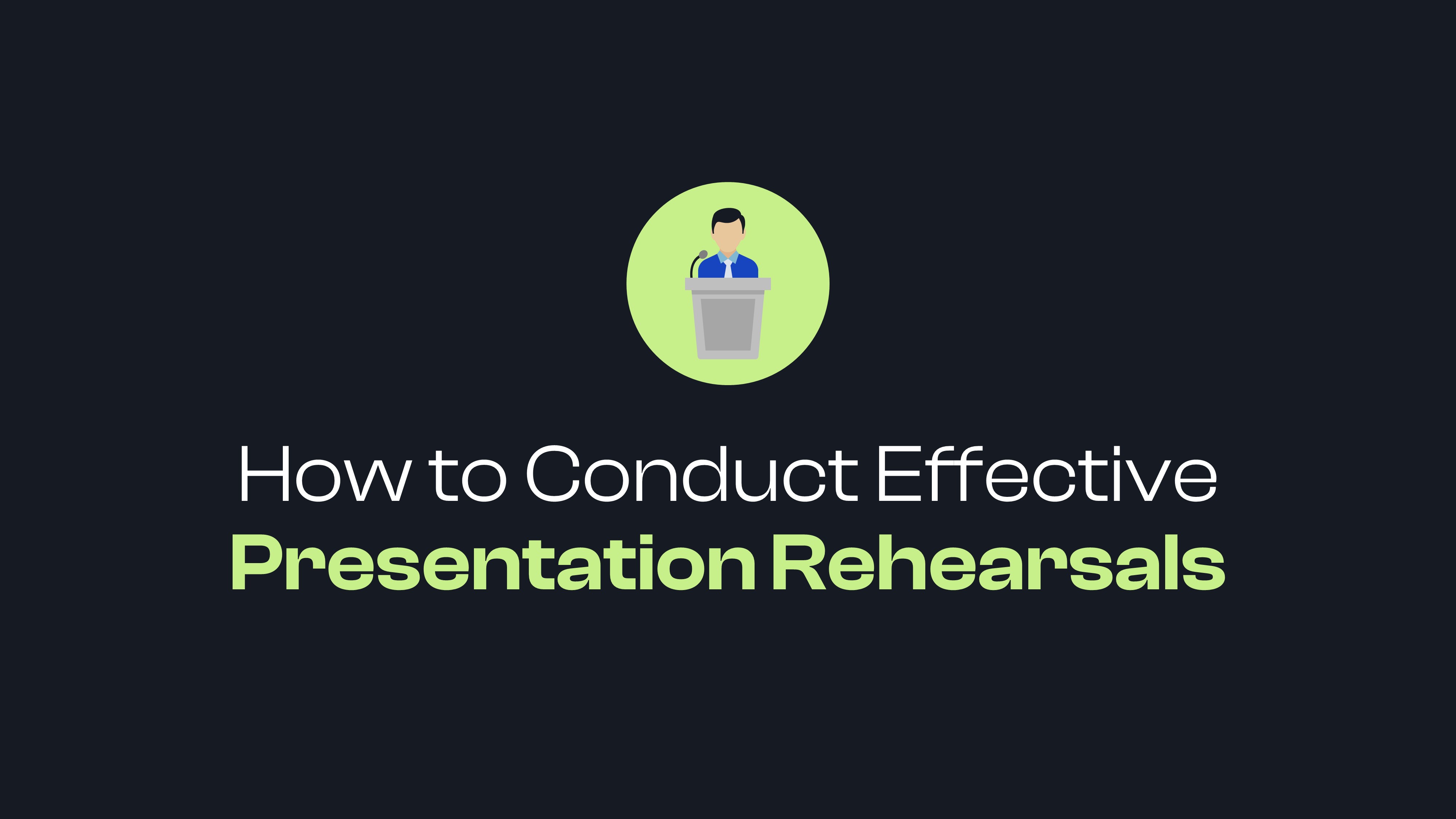How to Conduct Effective Presentation Rehearsals
5 minutes

When founders, executives, or sales teams stumble on stage, the root cause is rarely the slide design—it’s the lack of intentional rehearsal. In 2025, rehearsal is no longer just “run through it a couple of times.” AI coaching, hybrid work, and shortened attention spans have changed how we practise. Below is an end‑to‑end guide to rehearsing like a pro, complete with visual ideas so you can plug them straight into your deck or internal wiki.
1. Why Rehearsal Still Reigns
Confidence multiplier — rehearsing a presentation ~10 times measurably boosts speaker confidence and non‑verbal clarity.
Error insurance — every dry‑run reveals timing glitches, broken links, or awkward transitions before the audience does.
Cognitive loading — once content is “in the muscle,” you free up working memory to read the room and respond dynamically.
2. The Five‑Pass Rehearsal Method
Pass | Focus | Time | Output |
1. “Skeleton” | Story flow & slide order | 15‑20 min | Slide rearrangements |
2. “Voice” | Pace, filler words, vocal variety | 30 min | Script tweaks, pacing notes |
3. “Stagecraft” | Gestures, eye line, camera angle | 30 min | Movement cues, body language corrections |
4. “Tech‑Stack” | Clicker timing, screen‑share, embedded media | 20 min | Tech checklist |
5. “Dress Rehearsal” | Full run with audience & Q&A | 45 min | Final polish |
3. Rehearsal Formats to Mix & Match
Mirror Talk – great for first pass; flags content gaps.
Video Self‑Record – use your phone, OBS, or Zoom record; audit crutch words and posture.
AI Speaker Coach – PowerPoint’s “Rehearse with Coach” now scores pace, filler words, inclusivity, and body movement.
Peer‑Review Circle – invite two peers: one for content accuracy, one for delivery.
Venue Simulation – stand on the actual stage or use the exact webcam/mic setup for remote calls.
4. Setting Up Your Practice Lab
Camera at eye‑level to avoid power imbalance or awkward angles.
Neutral lighting (one key light, one fill) so AI coach reads facial cues.
Slide clicker or wireless keyboard to replicate real gestures.
Timer app (or built‑in PowerPoint timer) visible but non‑intrusive.
5. Quantify Your Growth: The Rehearsal Scorecard
Metric | Target | How to Measure |
Total duration | ±5 % of allotted time | Slide‑show timer |
Words per minute | 140‑165 wpm for comprehension | AI coach or script analytics |
Filler words / min | <1 | AI coach transcript |
Eye‑contact ratio | ≥70 % toward lens / audience | Video review |
Slide sync | 0–2 s lag on builds | Manual stopwatch |
6. The Feedback Loop
Self‑reflection – list two strengths, two areas to fix.
Peer rubric – 1‑5 scale on clarity, engagement, authority.
Iterate quickly – adjust slides, scripting, or gestures before next pass.
Pro tip: create a shared Google Form so every reviewer feeds data into a single dashboard.
7. Body Language & Vocal Dynamics
Stability below, dynamism above: feet anchored; hands animated for emphasis.
Own the space: walk purposefully during transitions, not randomly.
Vocal staircase: climb pitch on key questions, descend on takeaways.
8. Managing Nerves Through Rehearsal Rituals
Technique | Science | When to Use |
Box breathing (4‑4‑4‑4) | Lowers cortisol within 90 s | Pre‑run & pre‑live |
Power pose | Increases perceived confidence | 2 min backstage |
Mental imagery | Rehearses success, not failure | Night before |
9. Hybrid & Virtual Rehearsals
Bandwidth stress test: run slides while streaming 1080p video to check lag.
Screen‑share choreography: rehearse tab switching; silence notifications.
Camera‑lens engagement: tape a small photo of a friendly face next to the lens to anchor your gaze.
10. Scheduling: The 10×‑Rule
Aim for ten full‑volume, out‑loud run‑throughs spread over 7–10 days—spacing boosts long‑term recall far more than cramming the night before.
11. Tech Checklist for Final Dress Rehearsal
All fonts embedded, assets local (no broken links).
Clicker batteries fresh; backup clicker in bag.
HDMI/USB‑C adapters tested on venue projector.
Noise‑cancelling mic for remote delivery; check echo with colleague.
Backup PDF in cloud drive + on USB.
12. Quick‑Hit Rehearsal Hacks
Slide overlay timer – small transparent timer GIF on rehearsal copy to train pacing.
Emoji cue markers – tiny 😀 or 🔥 in speaker notes to remind facial expression.
Reverse rehearsal – start from last slide and work backward; exposes weak transitions.
Q‑card shuffle – shuffle printed key‑point cards and explain each out of order to test mastery.
13. The Ultimate Rehearsal Checklist
Story flow rock‑solid?
Talk time within ±5 %?
Filler words <1/min?
Gestures intentional?
Eye‑contact ≥70 %?
Slide builds synced?
Fonts embedded?
Backup files ready?
Venue tech tested?
Breathing routine rehearsed?
14. Conclusion: Rehearse to Release
Rehearsal isn’t about scripting yourself into a robot—it’s about freeing your cognitive bandwidth so you can be fully present when the spotlight turns on. Adopt the five‑pass method, leverage AI feedback, and iterate with data. By the time you step on stage or hit “Share Screen,” the mechanics fade away and the story shines.
Need a rehearsal partner or a deck makeover? Dots Presentations offers 1:1 coaching sessions and narrative‑led design so you look—and sound—ready for funding day.
Share our post



